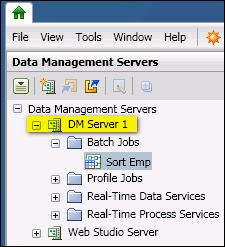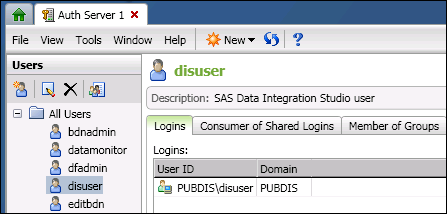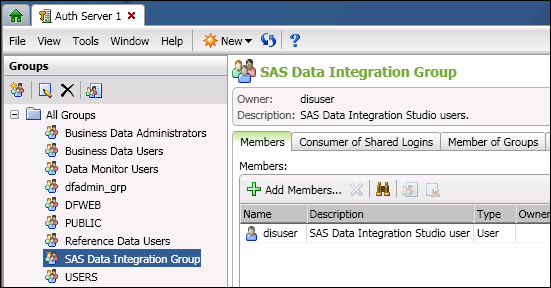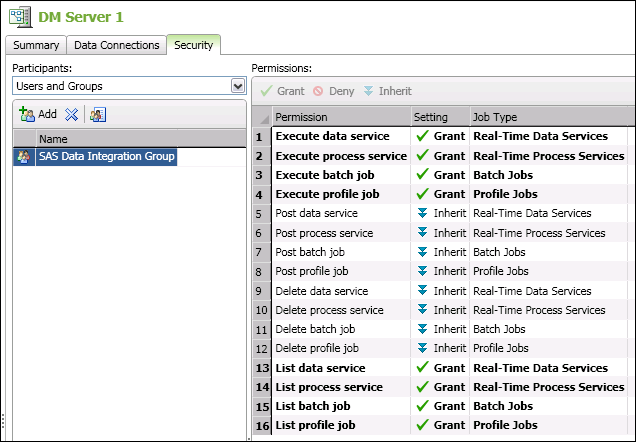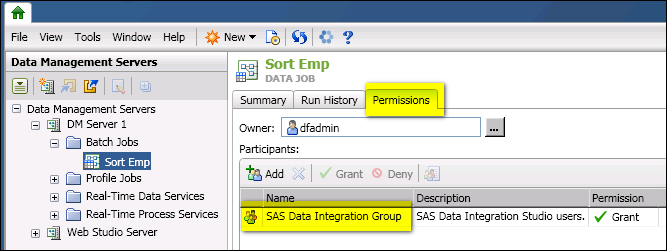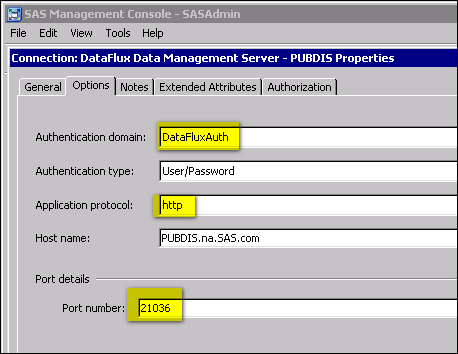Prerequisites for Running a Job When a DataFlux Server Is Used for Authentication
Overview
These prerequisites apply if you want to incorporate a DataFlux data job, process job, data service, or profile into the flow for a SAS Data Integration Studio
job. The job, service, or profile must be deployed to a DataFlux Data Management Server.
It is assumed that this server is secured with a DataFlux Authentication Server, as
described in the next section.
Verify How Users Are Authenticated on the DataFlux Data Management Server
SAS Data Integration Studio can access DataFlux jobs, services, or profiles if they
have been deployed to a DataFlux Data Management Server. In production environments,
this server is usually secured. It can be secured with either a DataFlux Authentication
Server or a SAS Metadata Server. SAS offerings that include SAS Data Integration Studio
4.8 and later typically use the SAS Metadata Server to authenticate users on a DataFlux
Data Management Server. The administrator who maintains your data management environment should know which authentication method
is being used to secure the server where the DataFlux jobs, services, or profiles
have been deployed.
If authentication is
handled by a DataFlux Authentication Server, then follow the steps
in the next sections. If authentication is handled by a SAS Metadata
Server, then see Prerequisites for Running a DataFlux Job or Profile in a SAS Data Integration Studio
Job.
Deploy the Job, Service, or Profile
A DataFlux Data Management Studio user deploys jobs, services, or profiles to a DataFlux
Data Management Server. He or she should ensure that the objects can be executed on
the server and that they deliver the expected results. The next display shows a job,
Sort Emp, that has been deployed to a server called DM Server 1.
For information about
deploying jobs, services, and profiles to a Data Management Studio,
see the chapters for data jobs, process jobs, and profiles in the DataFlux
Data Management Studio User’s Guide.
Register a User on the DataFlux Authentication Server
This task is performed on the Administration riser in DataFlux Data Management Studio.
The administrator for the DataFlux Authentication Server adds a user account to that
server. This user
account must have credentials that can be authenticated by the DataFlux Authentication
Server. Later, these login credentials are added to the SAS Data Integration Studio
user’s account in SAS Management Console. These login credentials enable the SAS Data Integration Studio user to list and
execute the deployed objects on the DataFlux Data Management Server. The example account
that is shown in the next display is for a user called disuser.
(Optional but recommended).
On the DataFlux Authentication Server, create a group for SAS Data
Integration Studio users. Add these users to that group. Having a
group for SAS Data Integration Studio users make it easier to grant
privileges to deployed objects. The example group that is shown in
the next display is called SAS Data Integration Group. Note that disuser
is a member of this group.
For details about adding
users and groups, see the DataFlux Authentication Server
User's Guide and the DataFlux Authentication
Server Administrator's Guide.
Grant Privileges on the DataFlux Data Management Server
This task is performed on the Data Management Servers riser in DataFlux Data Management
Studio. It is performed by the administrator for the DataFlux Data Management Server
where jobs, services, or profiles have been
deployed. This administrator grants the appropriate users or group the general permission
to list and execute deployed objects on the data management server. He or she also
grants the appropriate user or group access to these specific objects.
Note: Both the List permission
and the Execute permission must be granted to users or groups who
execute jobs, services, or profiles on a DataFlux Data Management
Server.
For example, you can
grant List and Execute permissions to the SAS Data Integration Group,
as shown in the next display.
Next, identify the individual
jobs, services, or profiles on the server that SAS Data Integration
Studio users should be able to execute. Grant the appropriate user
or group access to these specific objects. For example, you can grant
permissions so that the SAS Data Integration Group can access Sort
Emp, as shown in the next display.
For more information
about these tasks, see the “Security Administration”
chapter in the DataFlux Data Management Server Administrator’s
Guide.
Update or Add a Data Management Server Definition in SAS Management Console
This task is performed in SAS Management Console. It is performed by the administrator
who is in change of maintaining server definitions and other metadata for SAS Data
Integration Studio. If the SAS Data Quality Server and the DataFlux Data Management
Studio were installed on your site as part of a SAS offering, a server definition
is automatically created in SAS Management Console for the DataFlux Data Management
Server. An administrator should review this definition and check the following items:
-
Authentication domain. This field should specify a SAS authentication domain for the DataFlux Data Management Server where the jobs, services, or profiles have been deployed. If this field specifies the default SAS domain (DefaultAuth), replace the default with a new domain for the DataFlux context, such as DataFluxAuth.
-
Other fields. The values in the other fields should be appropriate for the DataFlux Data Management Server where objects have been deployed.
This definition enables
SAS Data Integration Studio to connect to the DataFlux Data Management
Server. An example definition is shown in the next display.
For more information about updating or adding server definitions, see the Help for
the Server Manager in SAS Management Console. See also the SAS Data Integration Studio
chapter of the SAS Intelligence Platform: Desktop
Administration Guide.
Update User Accounts in SAS Management Console
This task is performed in SAS Management Console by the administrator who is in change
of maintaining metadata for SAS Data Integration Studio. The administrator
updates the user account for the SAS Data Integration Studio user who must execute
DataFlux Data Management Studio jobs and other deployed objects. Add an appropriate
DataFlux Authentication Server user and login for this user, such as the disuser account
that is described in Register a User on the DataFlux Authentication Server. Specify the SAS authentication domain from the HTTP Server
definition above, such as the DataFluxAuth domain that is shown in
the next display.
For more information about adding logins to a user definition, see the Help for the
User Manager in SAS Management Console.
How the Connections Work
A user logs in to SAS Data Integration Studio as usual. If he or she tries to connect
to the DataFlux Data Management Server, the HTTP Server definition for that server
is accessed. Since this definition specifies the DataFluxAuth domain, the connection
searches the user’s account in SAS Management Console and finds the login for that
domain, and the connection is made to the DataFlux Data
Management Server.
The DataFlux Data Management Server checks for the appropriate permissions, and if
the appropriate permissions have been granted to this user, the job, service, or profile
is executed.
Copyright © SAS Institute Inc. All rights reserved.
